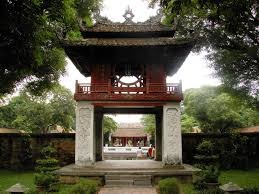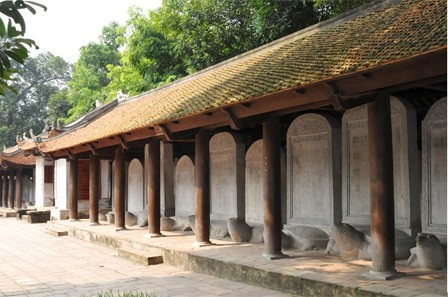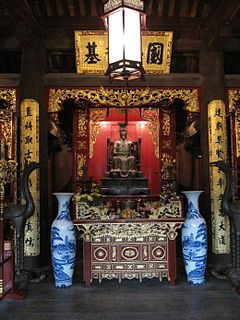Hello and welcome to VOV’s Letter Box, our weekly feature dedicated to listeners throughout the world. We are Mai Phuong and Ngoc Huyen.
A: First on our show today, we’d like to say hello to Neelakandan Visvanathan of India. Neelakandan reported listening to our broadcast on June 10 from 01:00 to 01:27 UTC on the frequency of 12005 KHz with SINPO rated at 45433. He wrote
: “It is interesting to hear about the peace worshiping ceremony in Vietnam. Nowadays, peace is no there in the world. There are conflicts and deaths in the world. So the peace worshiping ceremony is very appropriate in today’s world and every one must worship peace, so that the world of future will be safe and fine”.
B: Thank you, Neelakandan, for tuning into our programs. We’ll send you our QSL card to confirm your listening. Today, we’d like to welcome Derek Hickok, a new listener from the US, who first tuned into our broadcasts on July 24 on the frequency of 12005 KHz.
A: Derek wrote: “The radio I listened on was a Grundig S450 DLX and the SINPO was 45344. Very strong signal with no interference, but a little bit of fading. Very good overall signal though. It was my first time listening to your broadcast and plan to listen often as I really enjoyed it”.
B: Derek, we hope to hear more from you. This week, Jayanta Chakrabarty from India said he liked the live video recording of Toi la ngoi sao or I’m a star on VOV5 website at vovworld.vn. Jayanta wrote: “I enjoyed the song, lyric and music though I could not pick up the meaning. But, music has no language barrier as long as it is melodious and enjoyable. Singer Hien Thuc has done that. Thanks VOV for giving me an opportunity to have an insight to the modern music scene in Vietnam”.
A: Mohammad Shamim from India reported listening to our broadcast on July 9 from 1600 to 1630 UTC on the frequency of 7220 Khz with SINPO rated at 43434. Mohammad said he’d like to know about the oldest university in Vietnam.

Temple of Literature in Hanoi |
B: Well, the oldest university in Vietnam is also known as the Temple of Literature, which is about 2km west of Hoan Kiem Lake in downtown Hanoi. The Temple of Literature is a rare example of well-preserved traditional Vietnamese architecture. Founded in 1070 by King Ly Thanh Tong, the temple is dedicated to Confucius (Khong Tu) and honours Vietnam’s finest scholars and men of literary accomplishment. Vietnam’s first university was established here in 1076. At this time entrance was only granted to those of noble birth, but after 1442 a more egalitarian approach was adopted and gifted students from all over the nation headed to Hanoi to study the principles of Confucianism, literature and poetry.
A: In 1484 King Le Thanh Tong ordered that steles be erected to record the names, places of birth and achievements of exceptional scholars: 82 steles remain standing. The steles correspond to 82 examination courses from 1442 to 1779. If you visit the temple at the beginning of the year or in May when many important examinations take place, you will catch sights of numerous students who come to pray for luck.

Steles of Doctors at Temple of Literature |
B: The imposing tiered gateway that forms the main entrance is preceded by a curious plaque, whose inscription requests that visitors dismount their horses before entering.
B: Paths then lead through formal gardens to the Khue Van pavilion, constructed in 1802, beyond which is a large square pond known as the Well of Heavenly Clarity.
A: The northern side of this courtyard is marked by a low-slung pagoda housing an extraordinary statue of a majestic-looking Confucius, depicted with a goatee and bearing scarlet robes, flanked by four of his disciples.
B: The fourth courtyard is dedicated to Confucius and his 72 honoured students, as well as Chu Van An- a famous teacher known for his devotion to teaching. This is also where local authorities choose to cherish brilliant students in Hanoi, like those with top entrance results to university or top graduation outcomes.
A: The last and also furthest courtyard is Thai Hoc house, which used to be Quoc Tu Giam- the first university of Vietnam. Thai Hoc house holds a small collection of old time costumes for students and mandarins, as well as explaining the process of taking and passing the national examination.

Worshiping teacher Chu Van An in the Temple of Literature |
B: If you are keen on architecture, the Temple of literature has one of the most typical architectural style for centuries in Vietnam, composed of wood and tiles. Along the pass way are hundred-year-old trees that have witnessed the ups and downs of history.
A: That’s a short take on the Temple of Literature, the first university in Vietnam. Also from India, Santib Biswas listened to our program on June 25 on the frequency of 7220 with SINPO at all 4s. Santib said he would like to know more about the transportation system in Vietnam.
B: The Vietnamese railway network has a total length of 2,600 kilometers including 1,726 kilometer-single track north-south railway running between Hanoi and Ho Chi Minh City. There are more than 270 stations on the Vietnamese railway network, most of which are located along the north-south line. The Vietnamese railway network is owned and operated by the state-owned enterprise Vietnam Railway.
A: There are two railways connecting Vietnam to China: the western Yunnan-Vietnam railway from Hai Phong to Kunming and the eastern railway from Hanoi to Nanning.
B: Vietnam's road system is more than 222,000 km. Expressway is rather a new concept for Vietnamese, traffic is growing rapidly but the major roads are dangerous due to inappropriate design and an inappropriate traffic mix. Expressways would solve these problems along the key corridors, by separating high speed traffic from slower, local traffic.
A: Viet Nam currently recognizes two classes of expressway. Both have a minimum of two lanes in each direction. There are 4 design-speed categories: 60, 80, 100 and 120 km/h. Generally all cars, buses and trucks are permitted on the expressway except motorcycles of less than 70 cc.
B: Vietnam has more than 17,000 km of waterways; 5,000 km of which are navigable by vessels up to 1.8 m draft. Vietnam operates 37 civil airports, including three international gateways: Noi Bai, Da Nang, and Tan Son Nhat. Tan Son Nhat international airport in Ho Chi Minh city is the largest, handling 75 percent of international passenger traffic.
B: Before we go, we’d like to acknowledge letters and emails from Keith Ball of the US, Hannu Kiiski of Finland, Reiner Peuthert and Peter Erich of Germany, Fumito Hokamura of Japan, David Ansell of England, Giovanni Ricci of Italy, Samuel Carlos of Brazil, Ian Cattermol of New Zealand, Tjang Pak Ning of Indonesia, and SB Sharma and Bhaikan Hazarika of India. We’ll confirm your reports with QSL cards and the gifts you requested.
B: We welcome your feedback at: English section, Overseas Service, Radio Voice of Vietnam, 45 Ba Trieu Street, Hanoi, Vietnam. Or you can email us at: englishsection@vov.org.vn. You’re invited to visit us online at www.vovworld.vn, where you can hear both live and recorded programs. Good bye until next time.